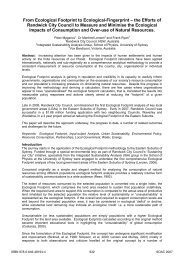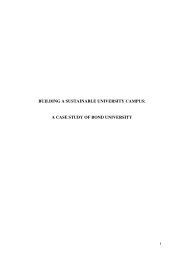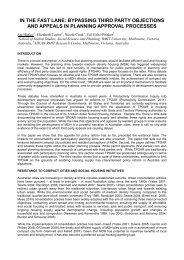How dense are we? Another look at urban density and transport ...
How dense are we? Another look at urban density and transport ...
How dense are we? Another look at urban density and transport ...
- No tags were found...
You also want an ePaper? Increase the reach of your titles
YUMPU automatically turns print PDFs into web optimized ePapers that Google loves.
<strong>How</strong> <strong>dense</strong> <strong>are</strong> <strong>we</strong>?The US cities, apart from New York, have the lo<strong>we</strong>st r<strong>at</strong>es of public <strong>transport</strong> use <strong>and</strong> theCanadians the highest, with Australia in-bet<strong>we</strong>en. The same n<strong>at</strong>ional p<strong>at</strong>terns <strong>are</strong> app<strong>are</strong>nt forwalking r<strong>at</strong>es, which <strong>are</strong> generally highest where public <strong>transport</strong> use is highest. Smaller citiestend to have more walking than larger ones; they also tend to have lo<strong>we</strong>r densities. Cycling isof negligible importance across all three countries, but a similar p<strong>at</strong>tern applies to th<strong>at</strong> withwalking: the Canadian figures <strong>are</strong> highest, despite the country’s inclement <strong>we</strong><strong>at</strong>her.Car usage r<strong>at</strong>es <strong>are</strong>, n<strong>at</strong>urally, the reverse of the other modes, lo<strong>we</strong>st in Canadian cities <strong>and</strong>New York; highest in the United St<strong>at</strong>es. Again, <strong>density</strong> is a poor predictor of car usage r<strong>at</strong>es:New York <strong>and</strong> Ottawa <strong>are</strong> the only cities where the figure is below 70 per cent, but do nothave particularly high densities. When allowance is made for the underst<strong>at</strong>ement ofAustralian figures caused by the different methodology, Ottawa’s <strong>density</strong> is about the same asMelbourne’s.Los Angeles’ <strong>density</strong> of 27.3 persons per hect<strong>are</strong> is similar to the figure of 28.5 per hect<strong>are</strong>reported for Copenhagen in Kenworthy <strong>and</strong> Laube’s Millennium D<strong>at</strong>abase, <strong>and</strong> higher thanOslo’s reported <strong>density</strong> of 24.0 per hect<strong>are</strong>. Although comparisons should be madecautiously, as the European figures have been compiled differently, the gap bet<strong>we</strong>en NorthAmerica <strong>and</strong> Europe may not be as gre<strong>at</strong> as is generally believed. There is a larger distance in<strong>density</strong> bet<strong>we</strong>en LA <strong>and</strong> the higher-<strong>density</strong> European cities in the Sourcebook, but it shouldbe recalled th<strong>at</strong> most of these figures <strong>are</strong> over-st<strong>at</strong>ements, as they cover only the centralmunicipality not the entire <strong>urban</strong> <strong>are</strong>a.Like their North American counterparts, European central cities <strong>are</strong> surrounded by lo<strong>we</strong>r<strong>density</strong>suburbs, as the European Environment Agency confirms in its 2006 report Urbansprawl in Europe. The same difficulties of regional government th<strong>at</strong> prevented Newman <strong>and</strong>Kenworthy extracting region-wide <strong>density</strong> figures have also made it difficult to control l<strong>and</strong>usebeyond central city boundaries. ‘European cities have become much less compact’ thanksto ‘[n]ew <strong>transport</strong> investment, in particular motorway construction’. The report citesHelsinki, Copenhagen <strong>and</strong> Brussels among its examples of ‘sprawled’ cities, while Munich,Milan <strong>and</strong> Bilbao <strong>are</strong> listed as compact (EEA, 2006, pp. 11, 18, 13). The proposed solutions<strong>are</strong> improved regional planning <strong>and</strong> governance, with gre<strong>at</strong>er Munich cited as a model.European cities might be grappling with the problem of <strong>urban</strong> sprawl, but this has notprevented many of them establishing effective, region-wide public <strong>transport</strong> systems th<strong>at</strong>carry much higher sh<strong>are</strong>s of travel than in most US, Canadian <strong>and</strong> Australian cities (see Mees,2009).European cities have been less successful <strong>at</strong> controlling sub<strong>urban</strong> sprawl than theircounterparts across the English Channel, where green belts <strong>and</strong> strong n<strong>at</strong>ional policies haveworked against extremely low-<strong>density</strong> sc<strong>at</strong>tered growth. As a result, English <strong>urban</strong> <strong>are</strong>asprobably have higher overall <strong>urban</strong> densities than most of their continental counterparts,despite having less <strong>dense</strong> city centres: the English cities <strong>are</strong> more like Los Angeles, while theEuropeans <strong>are</strong> more like New York or Boston. But public <strong>transport</strong> in UK cities, except forLondon, is in serious decline, with mode sh<strong>are</strong> figures <strong>at</strong> the 2001 census similar to those ofAustralian cities <strong>and</strong> lo<strong>we</strong>r than Canadian cities, despite lo<strong>we</strong>r British incomes <strong>and</strong> carownership r<strong>at</strong>es (Mees, 2009).






